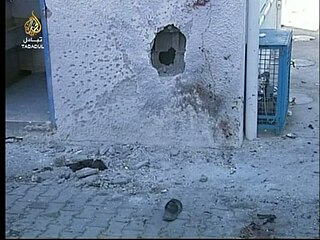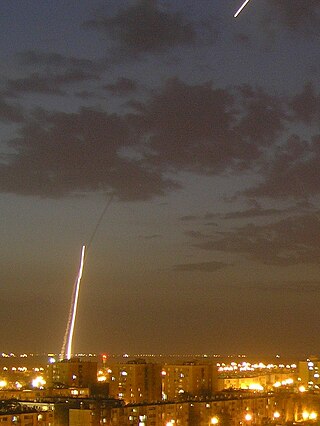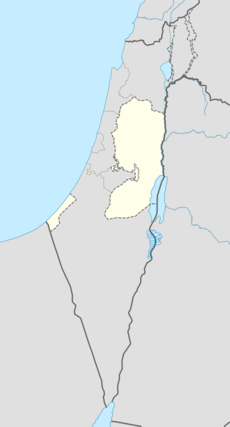In 2004 the Israeli Defense Forces launched Operation "Days of Penitence", otherwise known as Operation "Days of Repentance" in the northern Gaza Strip. The operation lasted between 29 September and 16 October 2004. About 130 Palestinians, and 1 Israeli were killed.
This page is a partial listing of incidents of violence in the Israeli-Palestinian conflict in 2005.
On June 9, 2006, an explosion on the beach near the Gaza Strip municipality of Beit Lahia killed eight Palestinians. At least thirty others were injured. The aftermath of the incident was captured on video and showed a distressed eleven-year-old girl, Huda Ghaliya, reacting to the loss of family members, most of whom were killed in the incident. The footage of Ghaliya, which received considerable media attention, was broadcast on news networks around the world, making her a symbol of Palestinian suffering. The German newspaper Süddeutsche Zeitung questioned the reliability of the video footage.
In 2006 the Israel Defense Forces launched Operation "Autumn Clouds" beginning on 1 November 2006, following numerous rocket and mortar attacks on southern Israel, when the Israeli Defense Forces entered the Gaza Strip triggering sporadic fighting near Beit Hanoun. The operation was the first military endeavor undertaken by the Israeli military since Operation "Summer Rains" in the summer of 2006. The operation was launched to stop Palestinian rocket attacks into Israel.
The 2006 shelling of Beit Hanoun by the Israeli Defence Force (IDF) happened on 8 November, when shells hit a row of houses in the Gaza Strip town of Beit Hanoun, killing at least 19 Palestinians and wounding more than 40. The shelling followed the IDF's withdrawal from the Gaza Strip in completion of a week-long operation codenamed Operation "Autumn Clouds", which the Israeli government stated had been intended to stop the Qassam rocket attacks on Israel by Palestinian militants. The Israeli government apologized and attributed the incident to a technical malfunction.
This is the Timeline of the Israeli–Palestinian conflict in 2007.

In 2008, Israel sought to halt the rocket and mortar fire from Gaza that killed four Israeli civilians that year and caused widespread trauma and disruption of life in Israeli towns and villages close to the Gaza border. In addition, Israel insisted that any deal include an end to Hamas's military buildup in Gaza, and movement toward the release of Corporal Gilad Shalit. Hamas wanted an end to the frequent Israeli military strikes and incursions into Gaza, and an easing of the economic blockade that Israel has imposed since Hamas took over the area in 2007.

In 2008 the Israel Defense Forces launched Operation Hot Winter, also called Operation Warm Winter, in the Gaza Strip, starting on February 29, 2008 in response to Qassam rockets fired from the Strip by Hamas onto Israeli civilians. At least 112 Palestinian militants and civilians, along with three Israelis, were killed, and more than 150 Palestinians and seven Israelis were injured.

Fadel Shana'a was a Palestinian journalist working as a cameraman for Reuters. He was killed, along with eight bystanders by a flechette shell fired by an Israeli tank in the Gaza Strip.

The Gaza War, also known as Operation Cast Lead, also known in the Muslim world as the Gaza Massacre, and referred to as the Battle of al-Furqan by Hamas, was a three-week armed conflict between Gaza Strip Palestinian paramilitary groups and the Israel Defense Forces (IDF) that began on 27 December 2008 and ended on 18 January 2009 with a unilateral ceasefire. The conflict resulted in between 1,166 and 1,417 Palestinian and 13 Israeli deaths.

The al-Fakhura School incident was an Israeli military strike that took place during the Gaza War on 6 January 2009 near a United Nations-run school in the Jabalia Camp in the Gaza Strip. According to UN and several non-governmental organizations (NGOs), more than 40 people were killed, most of them civilians. Israel reported the death toll as 9 Hamas militants and 3 noncombatants with senior IDF officers stating that the death toll published by Hamas was "grossly exaggerated". Israel stated it fired on the school in response to militant gunfire believed to be coming from al-Fakhura. A UN inquiry said that there was no firing from within the school and there were no explosives within the school.
Timeline of the Gaza War. For events pertaining to the conflict which occurred before 27 December 2009, see Gaza War (2008–2009)#Background and 2007–2008 Israel–Gaza conflict.

The Zeitoun incident refers to the Israeli military incursion, led by the Givati Brigade unit of the Israel Defense Forces (IDF), into the Zeitoun district of Gaza as part of the three-week 2008-09 Gaza War. In the Arab world, the name Zeitoun District Massacre is used to refer to any of the incidents in Zeitoun. A total of 48 residents of Zeitoun were killed, most of them women, children, and the elderly; 27 homes, a mosque and a number of farms were destroyed by Israeli forces.

The 2006 Gaza cross-border raid was an armed incursion carried out by seven or eight Gazan Palestinian militants on 25 June 2006 who attacked Israel Defense Forces (IDF) positions near the Kerem Shalom Crossing through an attack tunnel. In the attack, two IDF soldiers and two Palestinian militants were killed, four IDF soldiers were wounded, one of whom was Gilad Shalit, who was captured and taken to the Gaza Strip.

In November 2012, the Israel Defense Forces launched Operation Pillar of Defense which was an eight-day campaign in the Hamas-governed Gaza Strip, which began on 14 November 2012 with the killing of Ahmed Jabari, chief of the Gaza military wing of Hamas by an Israeli airstrike.

The 2014 Gaza War, also known as Operation Protective Edge , was a military operation launched by Israel on 8 July 2014 in the Gaza Strip, a Palestinian territory that has been governed by Hamas since 2007. Following the kidnapping and murder of three Israeli teenagers in the West Bank by Hamas-affiliated Palestinian militants, the Israel Defense Forces (IDF) initiated Operation Brother's Keeper, in which some 350 Palestinians, including nearly all of the active Hamas militants in the West Bank, were arrested. Hamas subsequently fired a greater number of rockets into Israel from the Gaza Strip, triggering a seven-week-long conflict between the two sides. It was one of the deadliest outbreaks of open conflict between Israel and the Palestinians in decades. The combination of Palestinian rocket attacks and Israeli airstrikes resulted in thousands of deaths, the vast majority of which were Gazan Palestinians.
The following is a timeline of the 2014 Gaza War. Over 2014, Palestinians suffered the highest number of civilian casualties since the Six-Day War in 1967, according to a United Nations report, given the July–August conflict, and rising tolls in the West Bank and East Jerusalem. A spike in Israeli casualties also occurred. 2,256 Palestinians and 85 Israelis died, while 17,125 Palestinians, and 2,639 Israelis suffered injuries.

The 2014 Israeli shelling of UNRWA Gaza shelters were seven shellings at UNRWA facilities in the Gaza Strip which took place between 21 July and 3 August 2014 during the Israeli-Gaza conflict. The incidents were the result of artillery, mortar or aerial missile fire which struck on or near the UNRWA facilities being used as shelters for Palestinians, and as a result at least 44 civilians, including 10 UN staff, died. During the 2014 Israel-Gaza conflict, many Palestinians fled their homes after warnings by Israel or due to air strikes or fighting in the area. An estimated 290,000 people took shelter in UNRWA schools.












